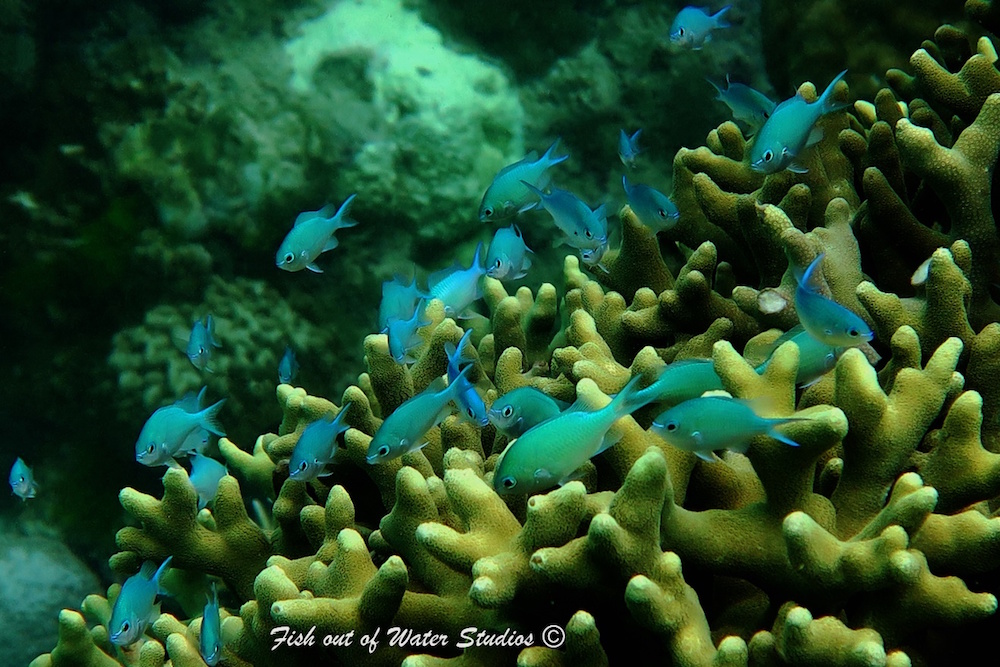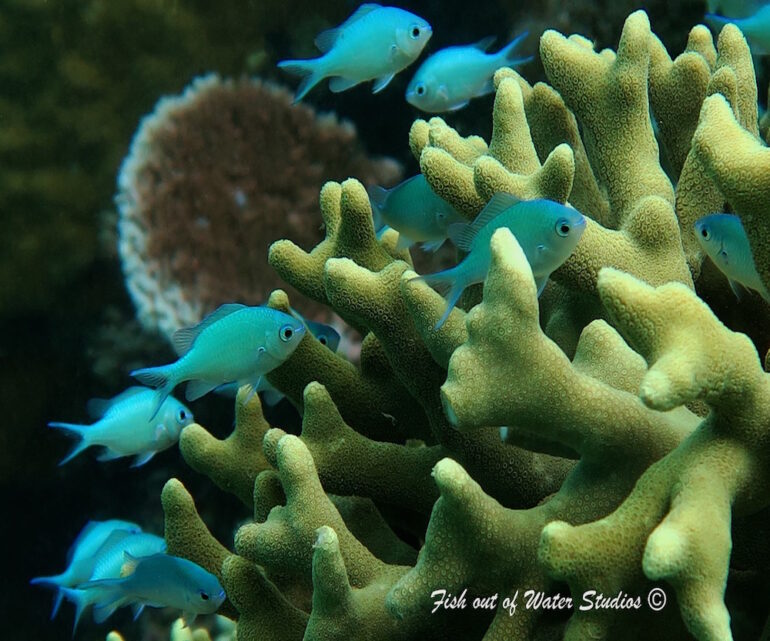The Black Axil Chromis
At first glance, these diamond blue fish could easily be mistaken for the Blue-green Chromis (Chromis viridis) that we often see widely represented in our hobby, until you look just a little closer. The Black Axil Chromis (Chromis atripectoralis) even shares many common traits, geographical placement, and appearance with the Blue-green Chromis.
A subtle clue was left in the scientific species name ‘atripectoralis’. Behind the pectoral fin of this fish is a black mark, and this can be viewed when the fin is moving in a forward motion.
Back to School
These peaceful community fish are seen in immense schools always sheltering near reefs, each school containing its own chain of hierarchy. This very apparent pecking order is a way of maintaining balance, order, and breeding within the school of fish.

We observe Black Axil Chromis intermingling with other chromis species like Blue-green chromis (Chromis viridis) and Ambon chromis (Chromis amboinensis), while darting in and out of large branched coral heads. The coral colonies serve as a defensive retreat whenever anything remotely startles the group and where they primarily rest at night.

Coral Correlation
The relationship Chromis have with Acropora species, in particular, is fascinating to watch and make us consider: Does the coral appreciate this association, as much as the fishes? The fact is, the Chromis’s fin movements gently fan away any detritus buildup on or within the branches promoting the overall health and growth of the coral. Some evidence has shown the corals may feed upon the waste produced by the sheltering fish.
Black Axil Chromis tend to feed face first into the currents, this generates a free flow of small crustaceans, fish eggs/larvae, filamentous algae, and planktons that they will readily devour. In the aquarium, they do well on a varied diet of Mysis shrimp, brine shrimp, and an occasional feeding of algae based flake food.
The Black Axil Chromis is a great choice for beginner reef aquarists, all the way up to aquarium professionals. They are a hardy fish when kept individually, or when in a school of 6 or more in an aquarium with good water quality and multiple feeding opportunities per day. They interact very well with the Blue-green Chromis (Chromis viridis) and other similar small body Chromis species in the aquarium.
Although the Black Axil Chromis belongs in the very large Pomacentridae family of Damselfishes and Anemonefishes, they are a very passive reef safe species and they tend to do better without more boisterous or semi-aggressive tankmates that might chase or bully them. Take precaution in stocking with other tankmates, like Pygmy Angelfish and some species of Anthias that are known to be aggressive or chase Chromis, it can cause undue stress, which can lead to infections or diseases.

Black Axil Chromis are susceptible to both bacterial infections and parasites, so we recommend a quarantine period for these fish prior to introduction to an established reef aquarium. If kept under good water quality conditions during this time, the Chromis will have a chance to develop their hierarchy within the school and adapt to feeding on the variety of captive foods offered.
We really appreciate the simple elegance of the Black Axil Chromis, we are intrigued by schools of these bright fish weaving in and out of SPS corals while surfing the invisible water currents. Their smaller size alone makes this a great fish to establish a school in a reef aquarium and maybe try to ‘spot’ one of these unique fish next time you are at your LFS.



